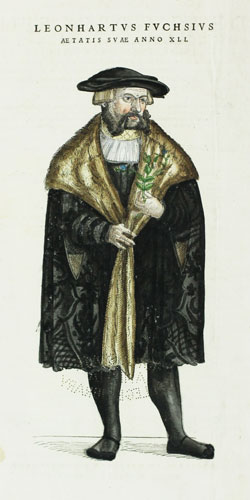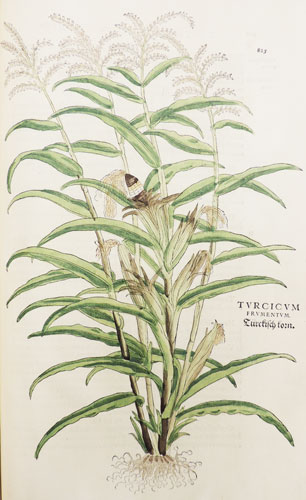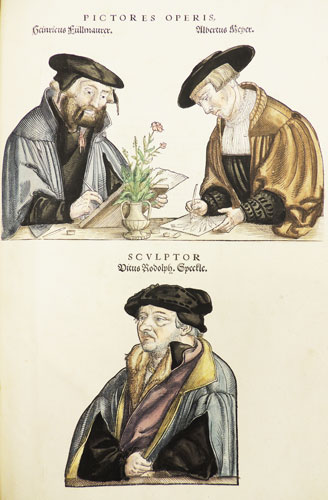Leonhart Fuchs
Leonhart Fuchs as depicted in De Historia Stirpium
Leonhart Fuchs was born in Wemding or Memmingen, Bavaria (now part of Germany) in 1501. He enrolled at the University of Erfurt at the age of 12 or 14. He was so intelligent he opened his own school at the age of 16. At 18 he attended Ingolstadt University in Ingolstadt, Bavaria to study classics, philosophy, and medicine. He became a physician in Munich in 1524 and later in 1526 returned to Ingolstadt as a professor. Then in 1528 he became the physician of Margrave George of Brandenburg, a Lutheran ruler of the territory of Brandenburg-Ansbach. He became well known among his contemporaries for his successful treatments during the Plague in 1529. In 1535 he became the Chair of Medicine at the University of Tübingen in Germany. There he created one of the first botanical gardens in the world.
His first writing was “Leonard Fuchs’ Notes on certain Herbs and Simples not yet rightly understood by the Physicians,” published as an appendix to the second volume of Brunfels’ Herbarum Vivae Eicones. He wanted physicians and pharmacists to use the same botanical names as the ancient philosophers.
Cover page from De Historia Stirpium
De Historia Stirpium was published in Latin in 1542. A German translation named New Kreuterbuch was released in 1543. An edition containing only plates was published in 1545 for the illiterate. The herbal was printed thirty-nine more times before Fuchs’ death in 1566. The folio editions of the book weighed about 11 lbs., but smaller pocket editions were later printed for use by field botanists. His book was intended for doctors and the general public. Fuchs was inspired by Brunfels’ book Vivae Herbarum Eicones. He hoped to outdo Brunfels. His introductory chapter “An Explanation of Difficult Terms” was the earliest botanical vocabulary list.
Some of the plates from his book were pirated for use in later herbals, including Bock’s New Kreuter Buch. His book was one of the first to include images drawn from nature. His artists generalized plants from nature to show the standard of a plant species. One image showed the different seasonal stages of the plant; this was done for economic reasons. He mistakenly thought some of the German plants he saw were the same plants described by Greek authors since he had never visited the Mediterranean.
Image of corn in De Historia Stirpium
De Historia Stirpium was the first herbal to illustrate native plants from the Americas. The book includes illustrations of pumpkins, chili peppers, and corn, among others.
De Historia Stirpium uniquely included images of the artists: Albrecht Meyer, Heinrich Fullmaurer, and Veit Rudolf Speckle. Meyer drew the illustrations, Fullmaurer transferred them to wood blocks, and Speckle created the woodcuts. The images were hand-colored after printing.
Call Number: Iowa State University Library Special Collections QK41. F951d



